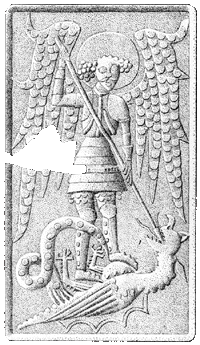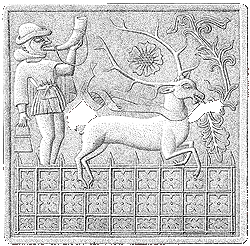The Český Krumlov Castle, the collection of the Gothic glazed stove tiles
"Written to the dear Country´s Conservation Office in
Prague.
An interesting variety of tile fragments was discovered in the
north slope below the Český Krumlov Castle during the tree stump
lifting. We excavated a large number of animal bones mixed with
many tile fragments in the place, where a kitchen of the Rožmberk
wing used to be situated. The storage place seems to have been used
to throw away all the kitchen waste and left-overs. The animal
bones are arranged tidily in contrast with the tiles which are only
littered all over the bottom. I assume that the tile fragments were
brought here during the castle restoration in the second half of
the 16th century. The tile fragments dating from the 14th, 15th,
and 16th century are mostly unglazed. Ornamental and figure
decorations, people, lions, eagles, different monsters,
coats-of-arms (14th and 15th century), Gothic inscriptions,
reticulation from Vladislav´s period, etc are remarkable. A small
part of tile fragments is glazed white, blue and green. It dates
back to the Renaissance period, perhaps Italian origin. I have not
managed to complete whole tiles from the excavated fragments so
far. Meanwhile, I would like to inform you about the
discovery.
Yours faithfully, Ing. Emil of Hartenthal, a conservator. In Český Krumlov, 8 November 1918 "
Duke Jan Schwarzenberg, a mansion owner, observed and paid towards the excavation of the incidental discovery containing a large number of Gothic and Renaissance stove tiles in the north slope below the Český Krumlov Castle in the late 1918. The Country´s Conservation Office in Prague informed about the discovery on account of the above mentioned letter written by Ing. Emil of Hartenthal - a supervisor of the Schwarzenberg Structural Management (The Structural Management of The Český Krumlov Mansion).
Emil of Hartenthal describes all the conditions in detail in his report. "A large number of tile fragments and animal bones was carried by wagons. The place of discovery is situated very close to The House of Rožmberks´ former bowers and the former chateau kitchen. The tiles are ornamented with the motives of holy persons, angels, coats-of-arms, inscriptions, riders, chasing animals and many others. Animals of different shapes are pictured in many fragments. Showing claws, baring teeth, fantastic monster outgrowth, everything seems to be fabulous"..
The collection of the late Gothic and Renaissance glazed stove tiles excavated in 1918 is the largest collection in South Bohemia (more than 4,500 preserved fragments) . The late Gothic icon-graphic motives (almost one hundred) rank among the most beautiful ones. The more numerous part of the Gothic collection (3,900 fragments) dates back to the first half of the 15th century and early 16th century. The Renaissance stove tiles date to the 16th century. The colour glazed tiles rank among the most beautiful specimens - (The Český Krumlov Castle, the collection of the Renaissance glazed stove tiles).
The most remarkable examples with Gothic ornamental motives. Order of Dragon of Zikmund of Luxembour.
The Knighthood Order of Dragon was established by Roman Hungarian King Zikmund and his wife Barbara Cejlská in 1408. Its holders were Hungarian aristocrats and many foreign personalities. The only Czech nobleman Čeněk of Vartemberk was given the Order of Dragon at the turn of 1419/1420. The dragon became a part of The House of Vartenberks´ coat-of-arms.
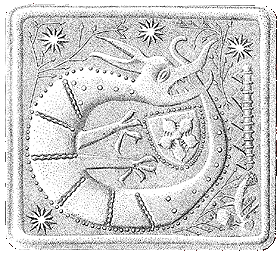
|
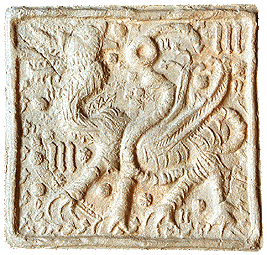
|
The Order of Dragon is known from many stove tiles. The dragon usually holds a coat-of-arms in its claws, which belongs to any of the families who were given the Order of Dragon by the king. And how come there is one in Český Krumlov? Čeněk of Vartenberk was Oldřich of Rožmberk´s guardian (1403-1462) and later he became his father in-law. He was accounted for a family member - as well as the order given him by Zikmund.
Dragon. A mythical beast. The large, winged, one-headed dragon is an example of medieval engravers.
Archangel Michael killing a dragon. JOne of frequent motives used in medieval art. St. John describes Michael and his angels´ fight against a giant dragon called a fiend and Satan in his revelation. Later Archangel Michael along with Gabriel and Rafael were considered being the most mighty angels on the bases of the Apocalypse. Their major mission was to lead the heaven army against the fiend. Michael is fully armed in one Krumlov relief. We can see an aureole instead of a helmet.
Adam and Eve next to the Tree of Knowledge. A very beautiful relief showing a well-known scene of a snake seducer. The snake with the human upper part body handing an apple to one of three sinners, and its snake tail wound round the stem tree. Adam and Eve´s genitals are covered with a bunch of fig leaves. The roof separates Paradise from the rest of the world represented by a bird of prey.
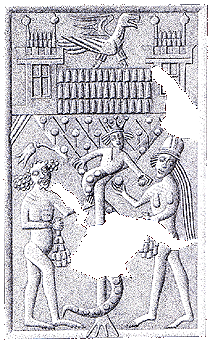
|
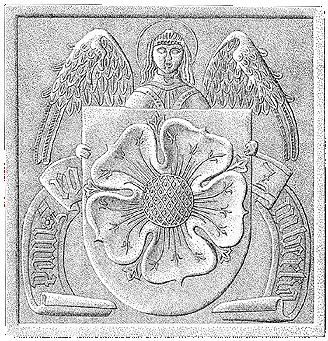
|
Shield-bearer Angel with The House of Rožmberks´ coat-of-arms. One of the most beautiful motives showing a shield-bearer angel holding a coat-of-arms ornamented with the Rožmberk five-petal rose. An engraver added the text "The House of Rožmberk" along the both sides of the coat-of-arms, in order to be clear at first sight, where a guest is and warms up his frozen limbs.".
Hunting scene. A beautiful relief of a five-petal rose placed between the hart antlers is closely connected with The House of Rožmberk. A large number of spellbound symbols is hidden in the motive, for example, a sprig in its mouth, a scarf wound around its neck, a rose between its antlers. a little fence and a bucket held by a hunter. His clothes are worked out in detail, including his hunting hat or belt with a buckle.
Samson killing a lion. A beautiful cut relief of brave Samson is the top of the Czech late Gothic tile creation. Besides many details, for example, a satchel and a knife, a cap and a feather, and an inscription "samson tisicz gich przemohl ue". Two last letters could be the engraver´s initials.
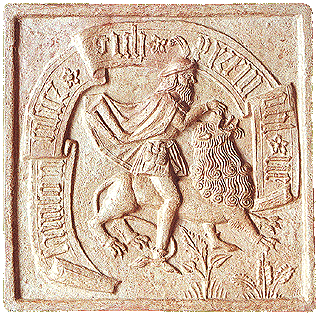
|
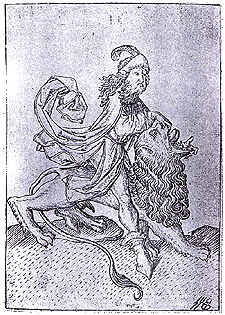
|
It is not very common that a concrete previous appearance of the art product is excavated preserved. The Krumlov tile ornamented with Samson is very unique. A copperplate engraving by Master craftsman ES was used. He was an artist who created in the early 15th century in the area called Upper Porýní.
(me)
Further information :
The
archaeological research of the medieval Český Krumlov
Castle
The
archaeological researches in the town of Český
Krumlov


